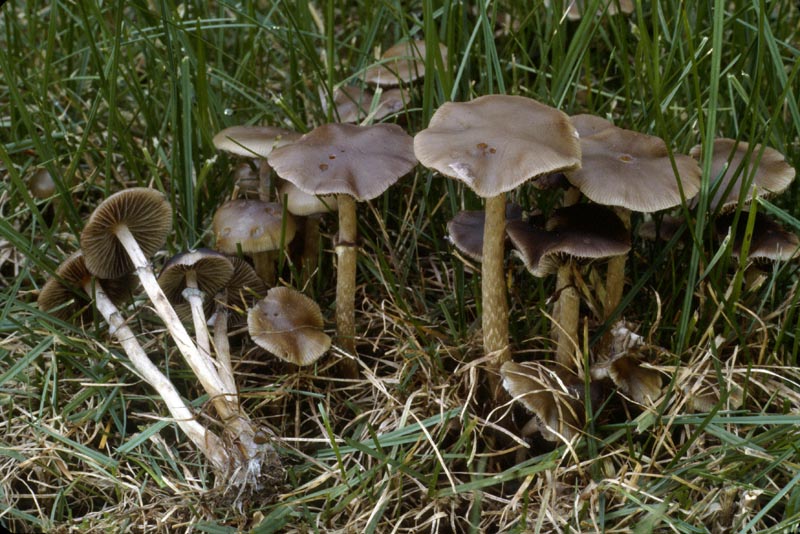Distribution: It is not often found in natural habitats. It is another species apparently confined to the Pacific Coast, particularly the PNW.
Habitat: P. stuntzii occurs frequently in well mulched newly planted lawns, as well as in wood chips and other landscape settings.
Substrate: Coniferous wood-chip mulch
Spores: September-December
Conservation Status: Not of concern
Edibility: Psilocybe stuntzii is considered weakly to moderately psychoactive. When collecting for such uses, it is imperative that one be sure of the identification and that each mushroom be checked carefully before being stuffed into the omnipresent plastic sandwich bag. Psychoactive psilocybes have a disturbing tendency to co-occur with potentially deadly galerinas and conocybes.
Cap: 1-4 cm broad, bluntly conical becoming convex to broadly umbonate, plane, or with an uplifted margin in age; surface smooth viscid when moist, color variable: deep-olive brown to chestnut-brown when young, but often fading as it ages or dries to dingy yellow-brown or yellowish-buff; margin striate when moist and often tinged greenish. Flesh thin pallid to brownish. Gills: adnate or adnexed, pallid soon becoming grayish or brownish; close or fairly well-spaced. Stalk: 2-6 cm long, 1.5-4 mm thick, equal or thicker at either end, often curved, yellowish to brown or sometimes with darker or bluish stains especially below; not viscid, often with mycelial threads at base. Veil: membranous but thin; forming a fragile ring or fibrillose zone on stalk which is often blue or bluish-green but eventually may be darkened by falling spores or may disappear. Spore print: dark purple-brown; spores 8-12 x 6-8 microns, elliptical, smooth. Chrysocystidia absent on gills.
Psilocybe stuntzii is considered weakly to moderately psychoactive. When collecting for such uses, it is imperative that one be sure of the identification and that each mushroom be checked carefully before being stuffed into the omnipresent plastic sandwich bag. Psychoactive psilocybes have a disturbing tendency to co-occur with potentially deadly galerinas and conocybes.
The most distinctive feature of Psilocybe stuntzii is the membranous ring that is usually present on the stipe; this is unusual for a psilocybe. Otherwise, it is fairly typical of the genus. The cap is conical at first, then becomes convex to plane. It is dark olivaceous brown, translucent-striate, and viscid when moist, and fades to a yellowish buff as it dries. The stipe is pale at first and darkens with age. The bluing reaction typically is weak, and usually is most noticeable on the ring. and is considered weakly to moderately psychoactive. When collecting for such uses, it is imperative that one be sure of the identification and that each mushroom be checked carefully before being stuffed into the omnipresent plastic sandwich bag. Psychoactive psilocybes have a disturbing tendency to co-occur with potentially deadly galerinas and conocybes, as shown in the accompanying photograph.
Sources: Trudell, Steve and Joe Ammirati. Mushrooms of the Pacific Northwest. Portland, Timber Press, Inc. 2009. Lincoff, Gary. National Audubon Society Field Guide to North American Mushrooms. New York, Alfred A. Knopf, 1981. Arora, David. Mushrooms Demystified. Berkeley, Ten Speed Press, 1986.
PNW Herbaria: Specimen records of Psilocybe stuntzii in the Consortium of Pacific Northwest Herbaria database
CalPhotos: Psilocybe stuntzii photos






